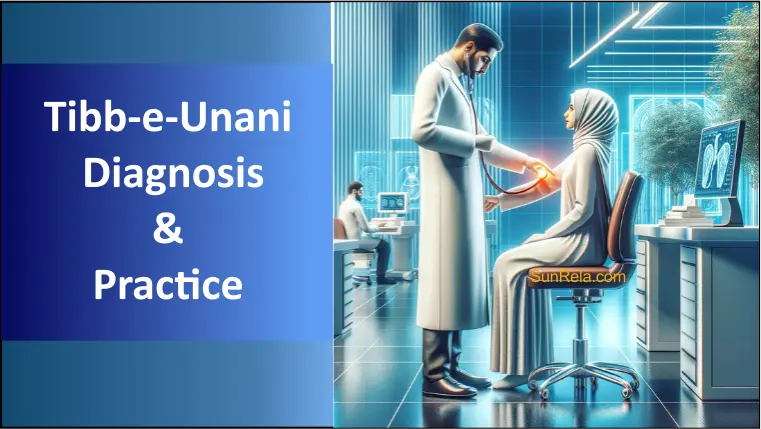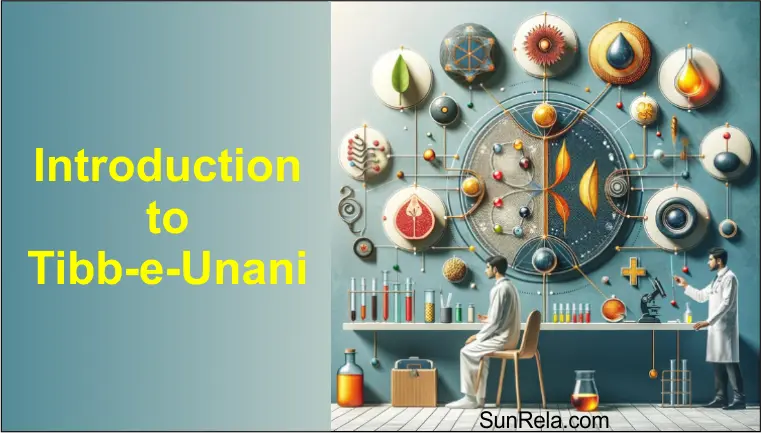How To Diagnosis, Tibb-e-Unani/Eastern Medicine | SR
Introduction
How To Diagnosis, Tibb-e-Unani/Eastern Medicine, for Diagnosis and Practice is a multifaceted process that goes beyond mere observation of symptoms. It includes understanding the patient’s environment, physical state, and emotional well-being.
Tibb-e-Unani/Eastern Medicine, also known as Unani medicine, is a traditional healing and health maintenance system observed in South Asia and parts of the Middle East. Rooted in the ancient Greek medical practices of Hippocrates and Galen, Tibb-e-Unani has evolved over centuries to integrate knowledge from various civilizations. It emphasizes the harmony between the body, mind, and environment and the role of a physician in maintaining this balance.
In Tibb-e-Unani (also Known as Unani medicine), diagnosis is a multifaceted process beyond mere observation of symptoms. It includes understanding the patient’s environment, physical state, and emotional well-being. This comprehensive approach ensures a holistic treatment plan that addresses the root causes of ailments.
- How To Diagnosis, Tibb-e-Unani/Eastern Medicine | SR
- Introduction
- How To Diagnosis, Tibb-e-Unani/Eastern Medicine, for Diagnosis and Practice is a multifaceted process that goes beyond mere observation of symptoms. It includes understanding the patient’s environment, physical state, and emotional well-being.
- Principles of Tibb-e-Unani Diagnosis
- Overview of Diagnostic Techniques
- Importance of Observing Environmental and Physical Factors
- The Role of a Tibb-e-Unani Physician
- Case Study: Personal Experience with a Patient
- Understanding Temperaments in Tibb-e-Unani (Unani medicine)
- How Temperaments Affect Diagnosis
- Pulse Diagnosis in Tibb-e-Unani
- Environmental and Physical Observations
- Case Studies and Real-Life Examples
- Patient Testimonials
- Challenges Faced by Tibb-e-Unani Practitioners
- Keep in mind, Greek medicine isn't confined to specific regions. It's founded on universal scientific principles that are universally applicable. These principles empower individuals to address health issues, regardless of their location.
- Integration with Modern Medicine
- The Future of Tibb-e-Unani in Modern Healthcare
- Conclusion
Principles of Tibb-e-Unani Diagnosis
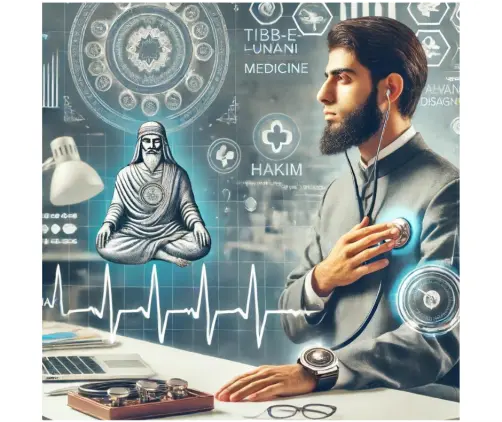
Overview of Diagnostic Techniques
Tibb-e-Unani diagnosis is an art that combines observation, palpation, and detailed patient history. The physician, known as Hakim, utilizes various techniques to assess the patient’s health:
1. Pulse Diagnosis: The pulse provides insights into the body’s balance of humor.
2. Observation: (The patient’s physical appearance, behavior, and emotional state are closely observed.
3. Inquiry: Detailed questioning about symptoms, lifestyle, diet, and medical history.
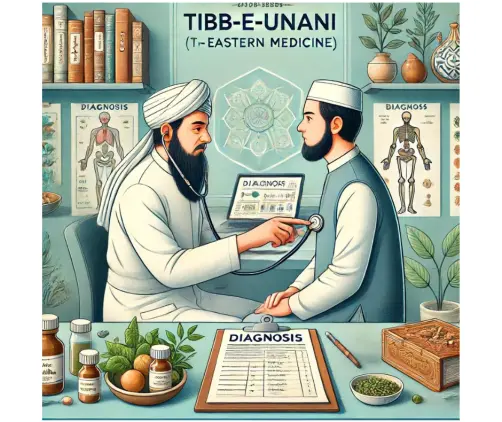
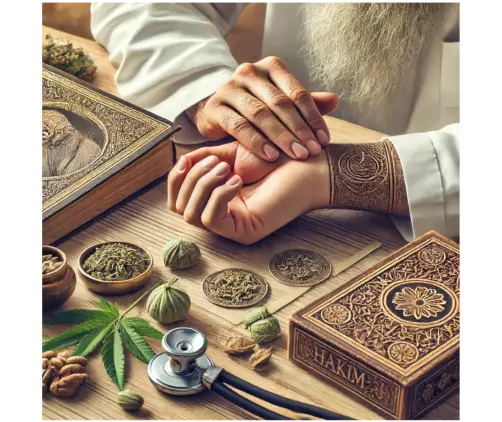
Importance of Observing Environmental and Physical Factors
Environmental factors such as weather, humidity, and living conditions significantly influence a person’s health. A skilled Tibb-e-Unani physician considers these aspects to tailor treatment plans. For instance, the same ailment might require different treatments in a humid climate than in a dry one.
The Role of a Tibb-e-Unani Physician
Skills and Training Required
Becoming a proficient Tibb-e-Unani (Unani medicine) physician requires rigorous training and practice. A deep understanding of classical texts, anatomy, physiology, and the properties of various herbs and compounds is essential. Additionally, practical skills such as pulse reading and observational techniques are honed over years of practice.
Case Study: Personal Experience with a Patient
I encountered a memorable case about 22 years ago while checking patients at my clinic. Two women wearing scarves entered the clinic. One of them was walking with difficulty. They both sat in the female waiting room. Soon, one of them expressed her impatience with a tone mixed with anger and pain.
When their turn came, I called them in—observing the patient’s pulse and asking her questions about her menstrual history and pain provided insights into her condition. This case demonstrated how environmental and physical observations, combined with pulse diagnosis, lead to an accurate diagnosis.
Understanding Temperaments in Tibb-e-Unani (Unani medicine)
Definition of Temperaments
Temperaments, or Mizaj, are fundamental to Tibb-e-Unani diagnosis. They describe an individual’s inherent balance of humor, which determines their physical and psychological characteristics. There are four primary temperaments:
1. **Sanguine (Damvi):** Warm and moist
2. **Choleric (Safravi):** Warm and dry
3. **Phlegmatic (Balghami):** Cold and moist
4. **Melancholic (Saudavi):** Cold and dry
How Temperaments Affect Diagnosis
Each temperament has distinct symptoms and disease predispositions. For instance, a choleric temperament might be more prone to inflammatory conditions. Understanding these temperaments helps the Hakim/Tabib tailor treatments to restore balance.
Pulse Diagnosis in Tibb-e-Unani
Detailed Explanation of Pulse Reading
Pulse diagnosis is a cornerstone of Tibb-e-Unani (Unani medicine). The physician places the tips of their fingers on the patient’s artery to feel the pulse. This technique reveals the pulse’s strength, rhythm, and quality, indicating the state of humors in the body.
Techniques and Practice
The skill of pulse reading requires meticulous practice. The physician feels the pulse at different depths and locations, interpreting the subtle variations in pressure and rhythm. This practice helps identify imbalances and guides the treatment plan.
Case Study: Pulse Diagnosis in Practice
In the previously mentioned case, the patient’s pulse revealed her temperament and the severity of her condition. The pulse felt hard and rapid, indicating an excess of heat and dryness, which aligned with her symptoms of menstrual pain and anger. This guided me in prescribing the appropriate treatment.
Environmental and Physical Observations
Assessing Weather, Humidity, and Surroundings
Environmental factors play a crucial role in Tibb-e-Unani (Unani medicine). For instance, cold weather can exacerbate phlegmatic conditions, while hot weather might worsen choleric conditions. The physician considers these factors when diagnosing and prescribing treatments.
Importance of Patient’s Physical State and Demeanor
Observing the patient’s physical state, such as skin color, eye condition, and overall demeanor, provides valuable diagnostic clues. For example, redness in the eyes might indicate an excess of bile, while pale skin could suggest phlegm dominance.
Case Studies and Real-Life Examples
Real-life cases illustrate the effectiveness of the Tibb-e-Unani diagnosis. Patients often report significant improvements after receiving treatments tailored to their temperaments and environmental conditions.
Patient Testimonials
Patient testimonials highlight the practical benefits of Tibb-e-Unani. One patient, after receiving treatment for menstrual pain, reported sleeping peacefully the first night after taking the prescribed medicine. Such testimonials underscore the system’s holistic approach and efficacy.
Challenges Faced by Tibb-e-Unani Practitioners
Practitioners of Tibb-e-Unani face several challenges, including skepticism from the modern medical community and a lack of standardized training. However, ongoing efforts aim to integrate traditional practices with modern healthcare.
Keep in mind, Greek medicine isn’t confined to specific regions. It’s founded on universal scientific principles that are universally applicable. These principles empower individuals to address health issues, regardless of their location.
Integration with Modern Medicine
Integrating Tibb-e-Unani with modern medicine involves adopting a complementary approach. Modern diagnostic tools and tests can enhance traditional practices, providing a more comprehensive healthcare solution.
The Future of Tibb-e-Unani in Modern Healthcare
The future of Tibb-e-Unani lies in its integration with modern medicine, offering a balanced approach to healthcare. As more research and collaboration occur, Tibb-e-Unani has the potential to contribute significantly to global health.
Conclusion
Tibb-e-Unani offers a holistic approach to diagnosis and treatment, considering environmental, physical, and psychological factors. A Tibb-e-Unani physician’s skills and knowledge are crucial in restoring balance and promoting health’s.


